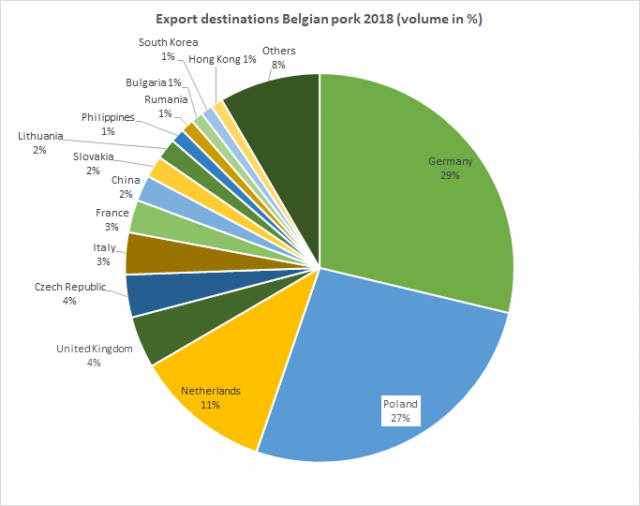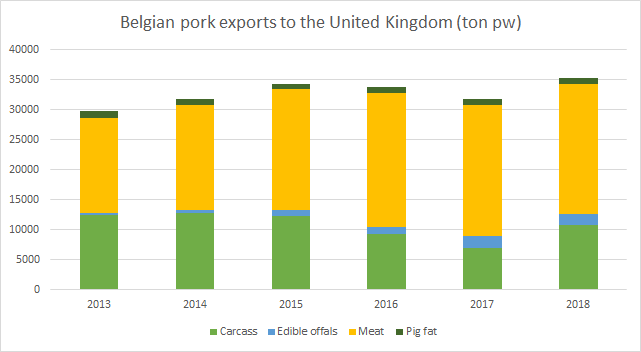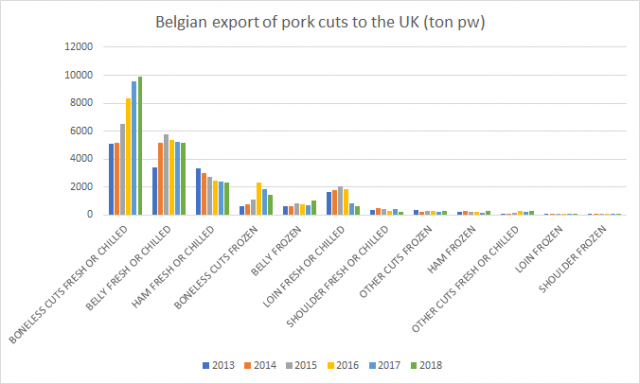Despite the discovery of African Swine Fever in the wild boar population, the export volume of Belgian pork rose by 3% to 816,609 tonnes in 2018. The Belgian pork sector did sell more pork on the European market. However, exports to third countries fell by 21%.
More Belgian pork sold within the EU
As a result of a large number of third countries closing their markets to Belgian pork, sales within the EU rose by 5.7% to 746,660 tonnes. Germany remains the main market, followed by Poland and the Netherlands.

Once again more pork to the United Kingdom
The United Kingdom is the fourth largest market for Belgian pork. After a fall in exports in 2016 and 2017, more Belgian pork once again crossed the Channel. In 2018 the volume exported was 35,190 tonnes, or 11% more than in 2017. Over a period of 5 years, the figures were also positive. From 2013 to 2018 the average annual growth rate was 3.4%.
Pork cuts remain the largest product category
Despite a sharp rise by 54% in the exports of carcasses to the UK in 2018, cuts continued to represent the lion’s share of exports to the UK. 61.4% of the total volume exported was made up of cuts, followed by carcasses (30.6%), edible offal (5.2%) and pork fat (2.8%).

Chilled, boneless cuts were the most popular. In 2018, their volume was almost 10,000 tonnes or 42% of the total volume of cuts exported. Chilled bellies (5,157 tonnes), chilled hams (2,332 tonnes), frozen, boneless cuts (1,413 tonnes) and frozen bellies (1,036) round off the top 5.

More exports to Poland, but less to Germany
What is remarkable is that exports to Germany fell once again by 8.2% to 234.672 tonnes. Thus, Germany's market share is now only 28.7%. In 2013 it was still 35%.
However, exports to Poland grew in leaps and bounds, reaching their zenith of 216,848 tonnes in 2018, an increase of 22.3% compared to 2017. In the last few months of 2018, Poland even knocked Germany from first place in terms of volume. The United Kingdom (35,190 tonnes), France (22,203 tonnes) and Italy (28,552 tonnes) also increased.
Sharp growth in the Baltic States
Other Eastern European countries, above all the Baltic States, became important growth markets. In 2018, the import into those countries was as follows:
- Lithuania: 14,150 tonnes, + 35.7%;
- Latvia: 7,288 tonnes, + 198.6%;
- Estonia: 2,542 tonnes, + 65.3%.
The growth for the Czech Republic is slowing down and exports now come to 28,982 tonnes. However, this was temporary since the last quarter, was the best ever.
Exports of Belgian pork to third countries falling
As expected, exports to third countries show a very different trend. In 2018, exports fell by 21.2% to 69,949 tonnes. African Swine Fever is clearly the most important factor in this. A large part of the exports of the Belgian meat suppliers previously destined for Asia now went to Africa (Ivory Coast, Democratic Republic of Congo, Ghana and Liberia).
The growth in exports to Vietnam is also remarkable. In 2018, exports came to 2,316 tonnes, no less than 321% more than in 2017. African Swine Fever does not appear to have played a decisive role in this since sharp growth figures were already apparent back in June.